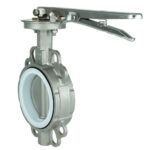
When you plan an industrial piping system, valve selection affects installation cost, space planning, maintenance workload and long-term operating cost.
Engineers and procurement managers often ask: “What is the main advantage of a butterfly valve?”
The short answer is: butterfly valves combine compact size, low weight and fast quarter-turn operation with good control for many applications.
That single combination often makes them the best choice where space, cost and speed of operation matter.
This article breaks that down in practical terms — what the advantage means on site, how it compares to other valves, and how to capture the benefit without sacrificing performance.
Quick takeaway: choose butterfly valves when you need a compact, economical valve that’s easy to install, quick to operate and well suited to automated systems — particularly for large diameters and moderate pressures.
“Main advantage” can be subjective depending on project priorities (cost, leakage, pressure drop, actuation speed). In practical procurement and operational terms, the dominant advantage of a butterfly valve is its excellent size-to-performance ratio:
Put simply — for the same bore size a butterfly valve saves space, weight and money while delivering acceptable control and shut-off for many duties. That combined advantage is why they are ubiquitous in water treatment, HVAC, food & beverage, and many process industries.
On projects the butterfly valve’s compactness drives concrete cost reductions. Example impacts we routinely see in bid studies:
For a 24″ line the difference in valve weight and flange size can translate into thousands of dollars saved in supports, installation and logistics. That’s why project managers often standardize on butterfly valves for large diameters where tight shut-off is not critical.
Procurement tip: when doing lifecycle costing, include installation, actuator and support savings — not just unit price — to see the true benefit.
No single valve is perfect. While butterfly valves offer a strong size/performance sweet spot, they have tradeoffs you must manage:
The practical consequence: specify the right butterfly sub-type (concentric, double-offset, triple-offset; soft vs metal seat) for your duty rather than defaulting to a single model.
There are scenarios where the main advantage becomes decisive:
Example: an HVAC contractor swapped bulky gate valves for wafer butterfly valves across a chilled water plant and reduced pump head losses and pump support costs while making valve automation simpler and cheaper.
To benefit from the main advantage, select the appropriate construction and materials:
Engineer’s checklist: match valve class (ANSI/ASME or PN), seat material and actuator torque rating to actual operating pressure, temperature and media.
The quarter-turn mechanism makes butterfly valves an excellent choice for automation. Benefits include:
In many plants, converting manual large-bore valves to automated butterfly valves reduces actuator footprint and simplifies control cabinet sizing — another practical reflection of the “main advantage”.
A municipal water authority replaced 36″ flanged gate valves on a distribution main with double-offset wafer butterfly valves during a pipeline upgrade. Results after 12 months:
Takeaway: the compact, lightweight and easy-to-automate nature of butterfly valves delivered measurable project benefits beyond the initial unit cost.
To realize the main advantage, avoid these common procurement/engineering mistakes:
Practical tip: include application duty cycle, media properties and temperature in the RFQ so vendors size seats and actuators correctly.
Feature | Butterfly Valve | Gate Valve | Ball Valve |
Typical best use | Large diameter, low/medium pressure, quick actuation | Full bore, high pressure, infrequent operation | Tight shut-off, small/medium diameter, frequent cycle |
Face-to-face / footprint | Compact (small) | Large | Moderate |
Weight | Light | Heavy | Moderate to heavy (large sizes) |
Operation | Quarter-turn | Multi-turn | Quarter-turn |
Sealing | Good (soft-seat) to excellent (triple-offset metal-seat) | Good, but slow and bulky | Excellent (especially metal seated designs) |
The main advantage of a butterfly valve — its compact size, light weight and fast quarter-turn operation —
translates into real project benefits: lower installation cost, easier automation and reduced lifecycle expenses
in many large-bore and retrofit applications. To capture that advantage you must select the correct butterfly
type, seat material and actuator sizing for your duty.
Need help specifying the right butterfly valve for your project? Our engineering team at DKV Valve can provide datasheets, torque calculations, and a project quote. Contact us to request technical support, sample units, or a customized proposal.
Poly Center T41601, Le Cong Town, Shunde District, Foshan City, Guangdong Province, China
We will contact you within 1 working day, please pay attention to the email with the suffix “@dkvchina.com”.
We will contact you within 1 working day, please pay attention to the email with the suffix “dkvchina.com”.